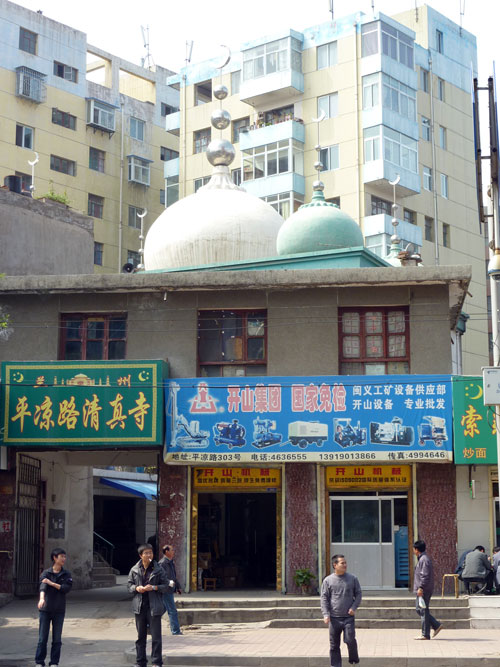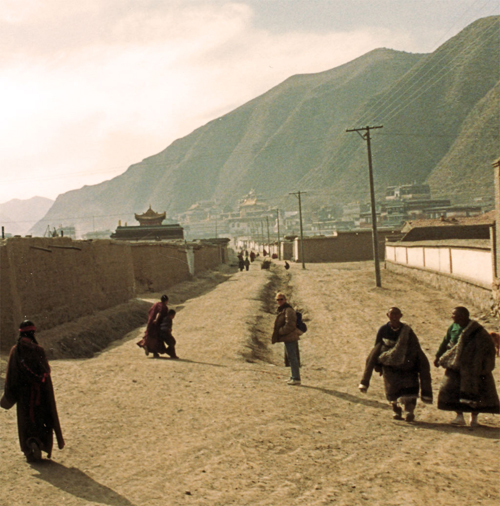Xiahe Revisited
Stage 7 of our 2011 trip (from our diaries) & Part one of a series of articles on Xiahe (Gansu Province) and the Labrang Monastery
Getting there from Lanzhou: 18/9/2011
Xiahe Revisted: 1990 / 2004 / 2011: When we emerge from our hotel at 6.00am to catch the 7.30 bus, it’s still pitch-black and still pouring with rain. Yet, we are lucky because for once there’s a taxi waiting by the gates, and we don’t even hit one of those infernal Lanzhou traffic jams! At the station, we find a handful of shivering passengers huddled in the spartan hall. The toilet is in a little shack to the right of the waiting room, with a gorgeous, but miserable-looking, soaking-wet Husky tied up out front.
Third Visit
The bus leaves on time, half-full and with only a couple of tourists on board, none of them Westerners. Our driver moves slowly and carefully down the brand-new, almost deserted, motorway. Adam starts reminiscing about how this ride once took 10 hours … back in 1990. For this is not our first visit to Xiahe, or even second, but our third!
We whizz through Linxia; now a large, bland, Chinese city, but then an exotic market town with a distinctly Muslim feel to it.
Suddenly there is Snow
Next, an amazing thing happens: we enter the third tunnel with rain drumming on the roof of our bus and streaming down the windows, and emerge onto a dry patch of road… There is snow on the mountains in the distance and, suddenly, our bus is driving through a flurry of snow as well. And this is only mid-September.
We are now in Tibetan territory: all the little settlements we pass have Tibetan names and the people wear Tibetan costume; the men with their heavy greatcoats, the women with their hair in braids and lots of colourful jewellery. There are monasteries up on the hillsides and cattle grazing in the lush, green fields.
Soon, after a smooth ride of about four hours, we arrive.
The Town
Since our last visit in 2004, Xiahe has expanded considerably. What used to be the town’s one and only street is getting longer and longer. In fact, it is no longer the only street either; there are a couple of shortish side streets now and even an ugly, modern square, dominated by the gleaming Civil Aviation Hotel, which is fronted by a couple of large, ungainly stone elephants.
The Overseas Tibetan Hotel
On our way to the Overseas Tibetan Hotel, once the only decent place in town, now one of many hotels and guest houses, we can appreciate the changes. There are many more shops, including a small mall chockablock with souvenir stalls, some modern apartment blocks of rather shoddy construction, and there is building work going on everywhere. Down by the river, just opposite the monastic village, a large, muddy piece of land is being cleared and developed.
There are many workers milling about the site, handling large trucks and heavy pieces of machinery. We later learn that the government is building a massive coach park, presumably to accommodate a massive, future influx of (mainly) Chinese tourists. To us, it seems nothing less than sacrilege. Surely, you can’t have revving engines, right next to the prayer wheels and pilgrims…
A little Bit of Politics
Over lunch, at a small American-run place specializing in pizza (we are chilled to the bone and in need of some comfort food), we get chatting to one of the guys running it. He tells us about the 2008 disturbances, when monks and townspeople came out en masse, to support the demonstrations in Lhasa. The protests were aimed at the Olympic Games being staged in Beijing and their objective was to draw the world’s attention to the lack of respect for human rights and freedoms in China, and Tibet in particular. Many demonstrators were killed, in Lhasa, in Gansu province and in Xiahe, while the protesting areas were closed off to visitors.
Nowadays, none of the locals will even mention the riots and nobody knows exactly how many people were killed, or imprisoned. The few foreigners living and working in the Tibetan areas are still having trouble getting permits and are regularly being cleared out by the authorities, whenever they are expecting trouble, for example around the anniversary of the riots.
The Labrang Hotel, or Labuleng Binguan,
Incidentally, the Labrang Hotel, or Labuleng Binguan, where we stayed in 1990, has apparently also fallen victim to the riots. It was used to house Chinese soldiers during the disturbances and consequently got wrecked… We haven’t got the heart to go and check it out for ourselves; we’ll just have to take our informant’s word for it.
Changes
A lot of the changes we had observed in Xiahe can be explained by this obsession of the Chinese authorities with containment and the stifling of any kind of dissent. The new apartments will most likely house Han Chinese migrants, many of them recent arrivals, brought in to counter-balance the Tibetan population, whereas the large hotels and the coach park are aimed at mass tourism, flocks of docile visitors, shepherded around by vigilant guides, with no time to ask awkward questions.
Practicalities
Labrang monastery: tickets for obligatory guided tours cost 40 Yuan. You’ll need the guide to unlock the temple halls for you. There are English tours around 10:15 and 15:15; the quality of the guides’ English varies, but seems to be improving. You will have to buy additional tickets for some of the outlying temples that can be visited without a guide.
Getting to and From Xiahe
From Lanzhou’s southern bus station there are many buses daily. You can also take a bus to Linxia and change to one of the many buses that ply the route between Xiahe and Linxia.
Heading South to Sichuan across the grasslands there are regular buses to Hezuo and the odd one to Zoige and Langmusi.
There is an early morning bus (7.00) to the interesting Qinghai town of Tongren. This bus crosses the Ganjia grasslands and passes through spectacular scenery.
Accommodation
Overseas Tibetan Hotel: we headed straight for the Overseas Tibetan Hotel, conveniently located at the monastery end of town, which we fondly remembered from our previous visit. We found the strongly-built, rather handsome Nepali owner busy distributing rooms to a Dutch tour group (Xiahe seems to be very popular with the Dutch). After a little bit of insisting we managed to secure a room for three nights for around 200 Yuan a night. Unfortunately, when we got to our room, it wasn’t quite the way we’d remembered: the brightly painted ceilings and colourful rustic furniture were still there, but the paint was peeling, the wallpaper held on with Sellotape and the bathroom verging on the decrepit… It was also bitterly cold. Morale: you might be better off checking out some of the more recent hotels in the Chinese new town; though nothing looked very atmospheric.
Food
There are plenty of cheap eateries all along the main street, serving a mix of Tibetan, Chinese, Muslim and Western dishes, but our favourite was the Nomad, both for its food and atmosphere.
Nomad restaurant
Climb up the dirty stone staircase and rickety metal one to emerge in a large, glass-fronted dining room with an adjoining rooftop terrace. The Nomad serves a hearty mix of traditional Tibetan dishes such as dumplings, or momos, thick noodle soups, and steaming plates of yak meat, Chinese ones like stir-fried vegetables and hot pots, and even some Western favourites like pizzas and chips. The clientele are an equally eclectic mix of local Tibetan nomads, red-robed monks and tourists.
The weather
One word of caution: our last two visits to Xiahe took place between mid and end of September, which is one of the best months for visiting China. But even then, the weather in Xiahe is extremely changeable: you may wake up to glorious sunshine, get caught in a cold drizzle at midday, and huddle in your unheated room in the afternoon, while the snow falls outside! So, come prepared.













We took the bus to Linxia hoping to catch another bus for Xiahe but no one could tell us where the station was in Linxia, it was the usual ‘bu tze tou’ or ‘mei you’ that infuriated me! Finally a taxi driver found his friend who had a private car to take us from Linxia to Xiahe, costs us 350 yuan. It was worth it for me, I had so wanted to see Labrang. I wasn’t disappointed. I wished I had more time, we could have gone to Langmusi also. We stayed at the Overseas Tibetan hotel even though our driver tried to steer us towards a Han Chinese place. It was raining too in Lanzhou, we got into a taxi which did not move because of the traffic jam. He kicked us out and we took the local bus to the main bus station. I’m planning to go to Lithang in August this year for the horse festival.